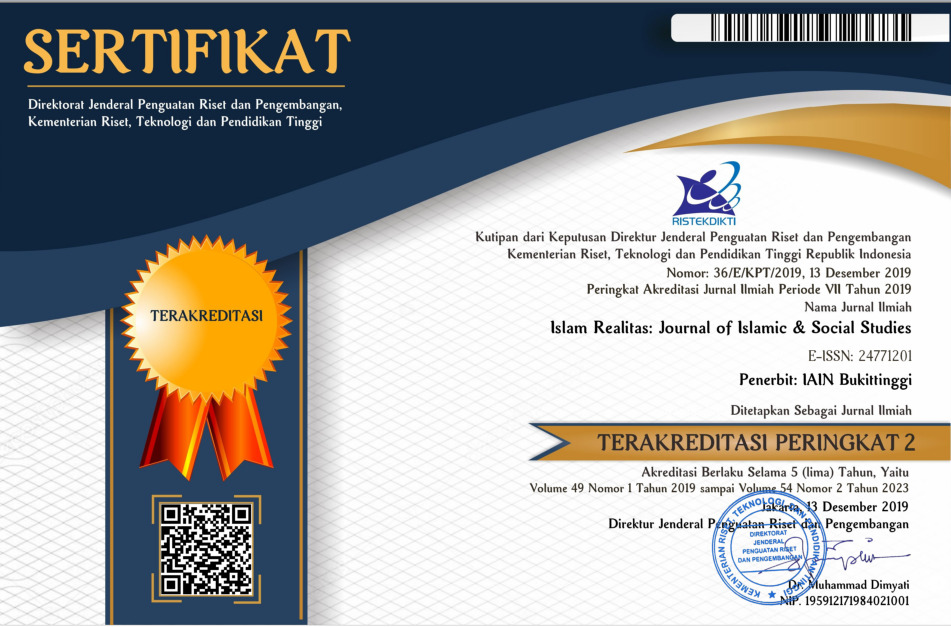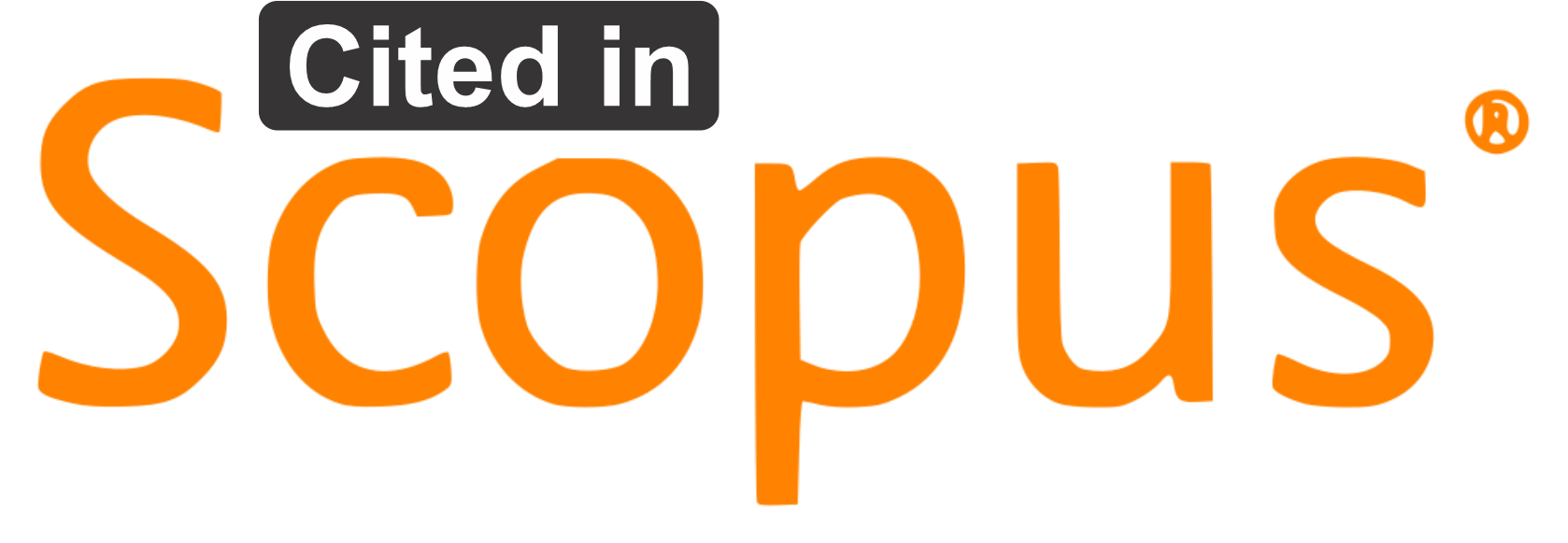Islamic Colleges in Central Sumatra in The 1930s-1950s: The Beginning Efforts of Bringing between The Islamic Science and The Western Science at Local Level
Downloads
This article discusses the discourse of Islamic Colleges in Indonesia and its realization at the local level with the establishment of Islamic Colleges in Central Sumatra, throughout the late 1930s to the 1950s.During that period, the initial discourse on Islamic Colleges in the national level went on sardonically, especially over bridging the Islamic sciences and general sciences (Western); the lingua francareferred to (Malay, Arabic, Dutch, or English); who should engender the Islamic Colleges; and who should manage them. This discourse at the national level involved prominent scholars like Satiman and Natsir, then Hatta in the following period. Their ideas were then realized in the form of the establishment of Colleges at the local level (regional), one of which was in Central Sumatra, during that period, there had been two Islamic Colleges: Sekolah Islam Tinggi (SIT) P.G.A.I in Padang in the late of colonial period and Darul Hikmah University (UDH) in Bukittinggi at the beginning of independence. Even though both of them were short-lived, they had become a prototype for Islamic Colleges in the following period as an effort to reconcile Islamic sciences and Western sciences, which is now popular as a science integration movement.
Artikel ini membahas diskursus sekolah tinggi Islam di Indonesia dan realisasinya di tingkal lokal dengan didirikannya sekolah-sekolah tinggi Islam di Sumatra Tengah sepanjang 1930an akhir hingga 1950an. Selama kurun itu, diskursus awal tentang pendidikan tinggi Islam di nasional berlangsung sengit, terutama bersoal menjembatani ilmu-ilmu keislaman dan umum (kebaratan); bahasa pengantar yang diacu (Melayu, Arab, Belanda, atau Inggris); siapa yang harus melahirkan sekolah tinggi Islam; dan siapa pula yang harus mengelolanya. Diskursus ini di tingkat nasional melibatkan para cendikiawan terkemuka serupa Satiman dan Natsir, lalu Hatta dan lain-lain di masa setelahnya. Gagasan-gagasan mereka kemudian direalisasikan dalam bentuk pendirian-pendirian perguruan tinggi di tingkat lokal (daerah), salah satunya di Sumatra Tengah, di mana selama kurun itu telah berdiri berturut-turut dua sekolah tinggi Islam:Â Sekolah Islam Tinggi (SIT) P.G.A.I di Padang pada masa akhir kolonial dan Universitas Darul Hikmah (UDH) di Bukittinggi pada awal kemerdekaan. Sekalipun keduanya berumur singkat, tetapi telah menjadi role models bagi sekolah tinggi Islam yang ada di periode setelahnya sebagai upaya yang sama untuk mendamaikan antara ilmu-ilmu keislaman dan kebaratan, yang sekarang populer sebagai gerakan integrasi ilmu.
Books
Abaza, Mona, Islamic Education: Perceptions and Exchanges: Indonesian Students in Cairo (Paris: EHESS, 1994)
Azra, Azyumardi, ‘IAIN di Tengah Paradigma Baru Perguruan Tinggi’, in Problem & Prospek IAIN: Antologi Pendidikan Tinggi Islam (Jakarta: Departemen Agama RI, 2003)
Dhofier, Zamakhsyari, ‘Refleksi atas Visi dan Misi IAIN’, in Problem & Prospek IAIN: Antologi Pendidikan Tinggi Islam (Jakarta: Departemen Agama RI, 2002)
Djamin, Muhammad Dalir, ‘Riwajat Ringkas Prof. H. Mahmud Junus’, in Brosur Menyambut Dies Natalis Ke-1 IAIN Al Djami’ah Imam Bondjol Sumatra Barat (Padang: Seksi Publikasi/Dokumentasi Panitia Dies Natalis ke-1 IAIN Al Djami’ah Imam Bondjol, 1967)
Garaghan, Gilbert J., A. Guide to Historical Method (New York: Fordham University Press, 1984)
Jabali, Fuad, and Jamhari, IAIN & Modernisasi Islam di Indonesia (Jakarta: Logos Wacana Ilmu, 2003)
Kuntowijoyo, Metodologi Sejarah, Edisi Kedua, (Yogyakarta: Tiara Wacana Yogya, 2003)
Lukens-Bull, Ronald A., Islamic Higher Education in Indonesia: Continuity and Conflict (New York: Pargrave Macmillan, 2013) <https://doi.org/10.1057/9781137313416>
Meuleman, Johan Hendrik, ‘IAIN di Persimpangan Jalan’, in Problem & Prospek IAIN: Antologi Pendidikan Tinggi Islam (Jakarta: Departemen Agama RI, 2002), p. 23
Natsir, Muhammad, Capita Selecta (Bandung: Penerbit Bulan Bintang, 1973)
Rahman, A Malik, ‘Sekelumit dari Sedjarah Berdirinja IAIN Sebagai suatu Al Djami’ah “Imam Bondjol†di Sumatra Baratâ€â€™, in Brosur Menyambut Dies Natalis Ke-1 IAIN Al Djami’ah Imam Bondjol Sumatra Barat (Padang: Seksi Publikasi/Dokumentasi Panitia Dies Natalis ke-1 IAIN Al Djami’ah Imam Bondjol, 1967), p. 2
Samry, Wannofri, and Yudhi Andoni, Demi Kejayaan Bangsa, Sejarah 50 Tahun Universitas Andalas (Padang: Unand Press, 2006)
Schroeder, Ralph, and Christopher Lloyd, The Structures of History., The Journal of the Royal Anthropological Institute (Blackwell Oxford, 1995), I <https://doi.org/10.2307/3034263>
Tim Kementerian Penerangan, Sumatera Tengah (Jakarta: Penerbit Kementerian Penerangan, 1953)
Yunus, Mahmud, Sedjarah Islam di Minangkabau: Keringkasan (Jakarta: Al-Hidajah, 1971)
———, Sedjarah Pendidikan Islam di Indonesia (Jakarta: Hidakarya Agung, 1996) <https://scholar.google.com/scholar?hl=en&q=pendidikan+islam&btnG=&as_sdt=1%2C5&as_sdtp=#3>
Yunus, Yulizal, IAIN Imam Bonjol 30 Tahun (Padang: IAIN IB Press, 1996)
Zed, Mestika, Sumatera Barat di Panggung Sejarah 1945-1995 (Padang: Bidang Penerbitan Khusus Panitia Peringatan 50 Tahun RI Sumatera Barat, 1995)
Zed, Mestika, and Hasril Chaniago, Perlawanan Seorang Pejuang. Biografi Kolonel Ahmad Hussein (Jakarta: Sinar Harapan, 2001)
Journals
Feener, R. Michael, ‘Indonesian Movements for the Creation of a “National Madhhabâ€â€™, Islamic Law and Society, 9 (2002), 83–115 <https://doi.org/10.1163/156851902753649298>
Ikhwan, Afiful, ‘Perguruan Tinggi Islam dan Integrasi Keilmuan Islam : Sebuah Realitas Menghadapi Tantangan Masa Depan’, Juran At-Tajdid, 5 (2016), 159–87
Indra, Hasbi, ‘Pendidikan Tinggi Islam dan Peradaban Indonesia’, Al-Tahrir: Jurnal Pemikiran Islam, 16 (2016), 109 <https://doi.org/10.21154/al-tahrir.v16i1.317>
Minhaji, Akh., ‘Masa Depan Perguruan Tinggi Islam di Indonesia; Perspektif Sejarah-Sosial’, Tadris Jurnal Pendidikan Islam Jurusan Tarbiyah STAIN Pamekasan, 2 (2007), 154
Nathan, Andrew J., and Andrew Scobell, ‘How China Sees America’, Foreign Affairs, 91 (2012) <https://doi.org/10.1017/CBO9781107415324.004>
Natsir, Muhammad, ‘Sekolah Tinggi Islam’, Pedoman Masjarakat, 6 (1938), 1–12
Roff, William R, ‘Indonesian and Malay Students in Cairo in the 1920’s’, Indonesia, 1970, 73–87
Salahuddin, Marwan, ‘Model Pengembangan Pendidikan Tinggi Islam di Indonesia’, Ulumuna, 18 (2017), 121–38 <https://doi.org/10.20414/ujis.v18i1.155>
Welch, Anthony, ‘Seek Knowledge throughout the World? Mobility in Islamic Higher Education’, Research in Comparative and International Education, 7 (2012), 70–80 <https://doi.org/10.2304/rcie.2012.7.1.70>
———, ‘Seek Knowledge throughout the World? Mobility in Islamic Higher Education’, Research in Comparative and International Education, 2012 <https://doi.org/10.2304/rcie.2012.7.1.70>
Wirjosandjoyo, Satiman, ‘Pendirian Sekolah Tinggi Islam’, Pedoman Masjarakat, 6 (1938), 1–12
Other references
Hardianti, ‘Pemikiran Politik Islam Soekiman Wirjosandjojo (1916-1960 M)’ {unpublish bachelor thesis, UIN Sunan Ampel, 2018}
Kinoshita, Hiroko, ‘Islamic Higher Education in Contemporary Indonesia: Through the Islamic Intellectuals of Al-Azharite Alumni’, in Kyoto Working Paper on Area Studies, No. 79 Kyoto University, 2009<https://repository.kulib.kyoto-u.ac.jp/dspace/bitstream/2433/155748/1/ssh_081.pdf>. {accessed 7 December 2019}
Authors who publish with this journal agree to the following terms:
- Authors retain copyright and grant the journal right of first publication with the work simultaneously licensed under a Creative Commons Attribution License that allows others to share the work with an acknowledgment of the work's authorship and initial publication in this journal.
- Authors are able to enter into separate, additional contractual arrangements for the non-exclusive distribution of the journal's published version of the work (e.g., post it to an institutional repository or publish it in a book), with an acknowledgment of its initial publication in this journal.
- Authors are permitted and encouraged to post their work online (e.g., in institutional repositories or on their website) prior to and during the submission process, as it can lead to productive exchanges, as well as earlier and greater citation of published work (See The Effect of Open Access).









